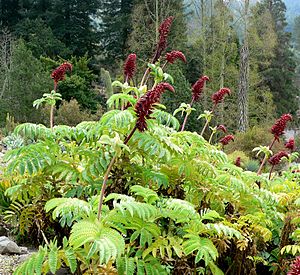Honey bush
| Honey bush | ||||||||||||
|---|---|---|---|---|---|---|---|---|---|---|---|---|

Honey bush ( Melianthus major ) |
||||||||||||
| Systematics | ||||||||||||
|
||||||||||||
| Scientific name | ||||||||||||
| Melianthus major | ||||||||||||
| ( L. ) |
The (large) honey shrub ( Melianthus major ) is a plant species within the honey shrub family (Melianthaceae). In its area of distribution, southern Africa, it is called English "Honey Flower" or Afrikaans "Kruidjie-roer-my-nie". The botanical genus name Melianthus is derived from méli for honey and ánthos for blossom.
Description and ecology
Vegetative characteristics
The honey shrub is an evergreen shrub or shrub reached, the plant height to 3 meters. The shoot axes usually have a circular cross-section, are often hollow and not very lignified . The original main shoot becomes bushy over time. The main growing season is the rainier winter. During longer periods of drought or severe frost , the above-ground parts of the plant die off, but when the weather conditions are favorable, the plant sprouts out of the underground part again.
The alternate and helically arranged leaves are pinnate unpaired, with 5 to 27 leaflets. The leaflets are 5 to 10 cm long and 2.5 to 3.5 cm wide, the edges are serrated. The leaf rhachis in the area of the leaflets is sometimes lobed with a serrated edge. The leaves can be up to 50 cm long. Above the petiole stands a smooth-edged stipule that encloses the stem axis and that tapers to a point and envelops the following stem bud. The color of the leaves, but also of the fresh twigs and leaf stalks, is a light blue-green, the surface is frosted. The leaves give off an unpleasant odor when touched (reminiscent of peanuts).
Generative characteristics
The terminal, racemose inflorescence contains many flowers. The hermaphrodite flowers are zygomorphic with a double flower envelope . The lower of the five fused sepals forms a more or less pronounced spur (mentum). The four red-purple to rust-red petals are free. There are two short and two long stamens , the short ones are fused with a membrane, which continues under the insertion at the base of the ovary into a large, brown, leathery honey cap, which is located in the spur. The "honey" (highly concentrated nectar ) flows as soon as the anthers have opened. A wreath of sterile flowers is sometimes formed at the tip of the inflorescence. The flowers secrete a large, dark drop of nectar that is edible; all other parts of the plant are poisonous. The pollination is effected by sunbirds ( ornithophily ).
Blister-like, pale green capsule fruits are formed which contain shiny black seeds .
distribution
The home of the honey bush is southern Africa , especially the Western Cape region , preferring locations along streams and ditches.
In Bolivia , India and the Canary Islands , for example , the honey bush is an invasive plant .
use
The nectar drops secreted by the flowers are collected and used as a sweetener. They are commercially available dried, for example as an additive to tea.
Medical use
Decoctions and poultices with leaves of the honey bush are used externally in South African folk medicine to treat rheumatism , bruises and wounds.
Toxicity
All parts of the plant contain cardiac glycosides of the bufadionelide type.
swell
- PlantZAfrica datasheet from the South African National Biodiversity Institute . accessed on September 26, 2012
- Melianthus major at Plants For A Future . Retrieved September 16, 2012.
Individual evidence
- ^ Johann Gottlob von Kurr : Investigations into the meaning of the nectaries in the flowers based on own observations and experiments , Henne Verlag, Stuttgart 1833 Online at books.google.de. , P. 71
- ↑ www.giftpflanze.com .

